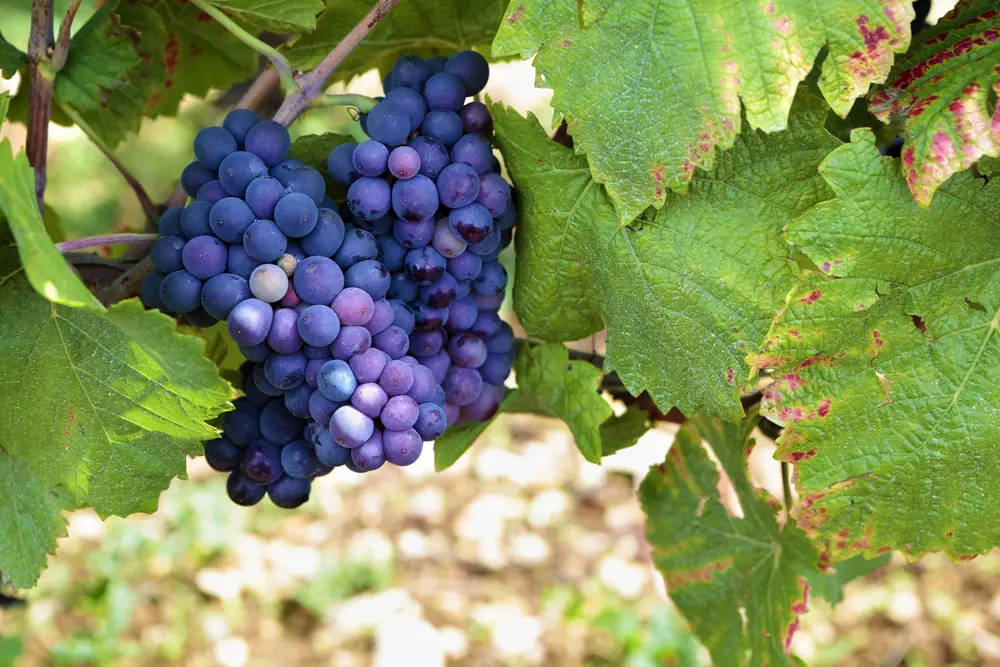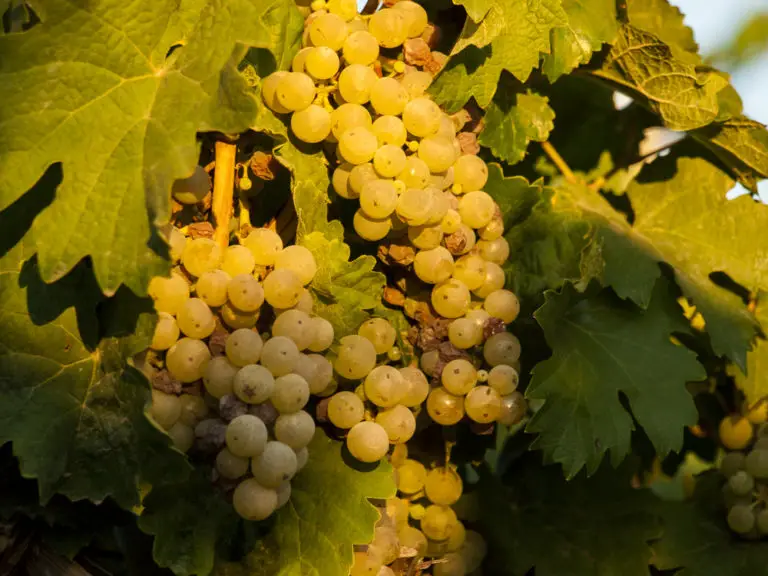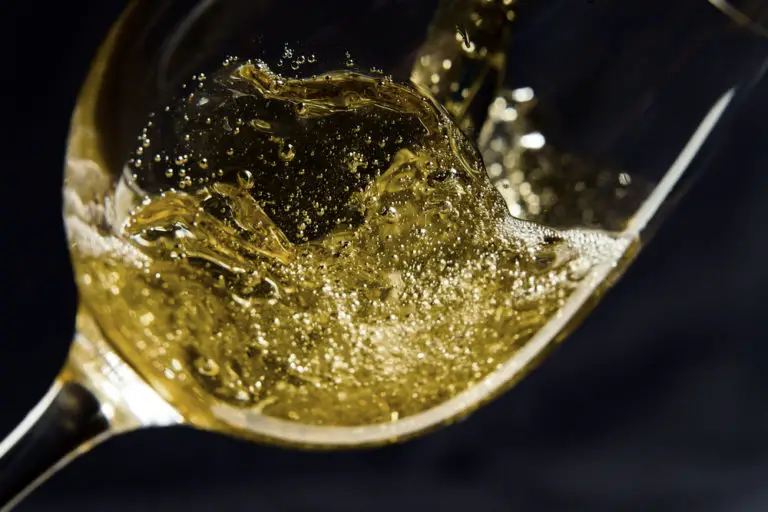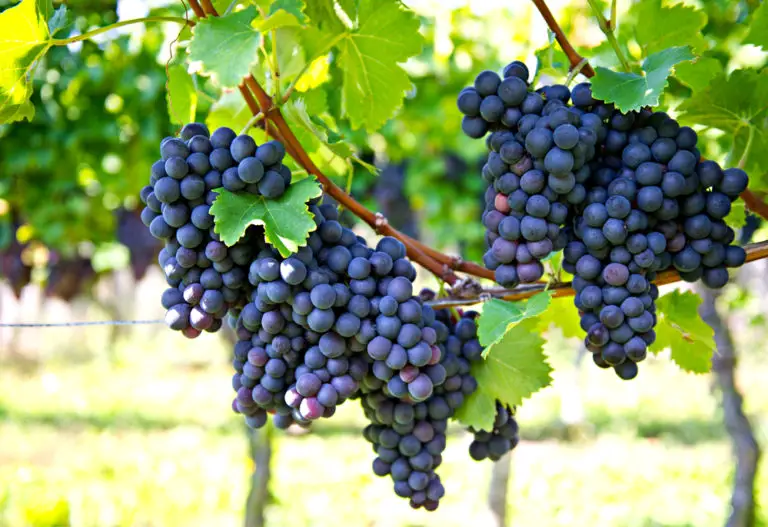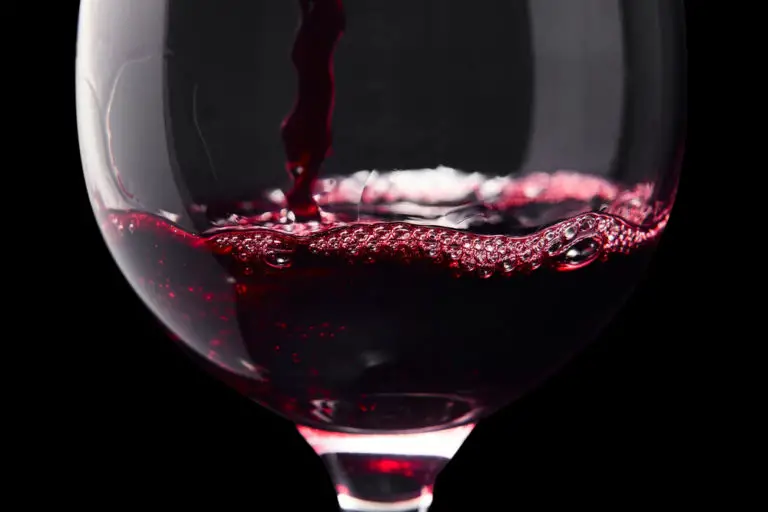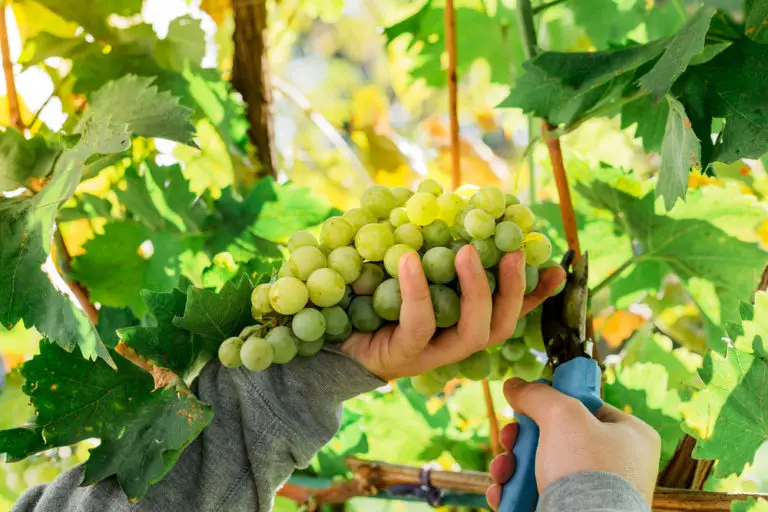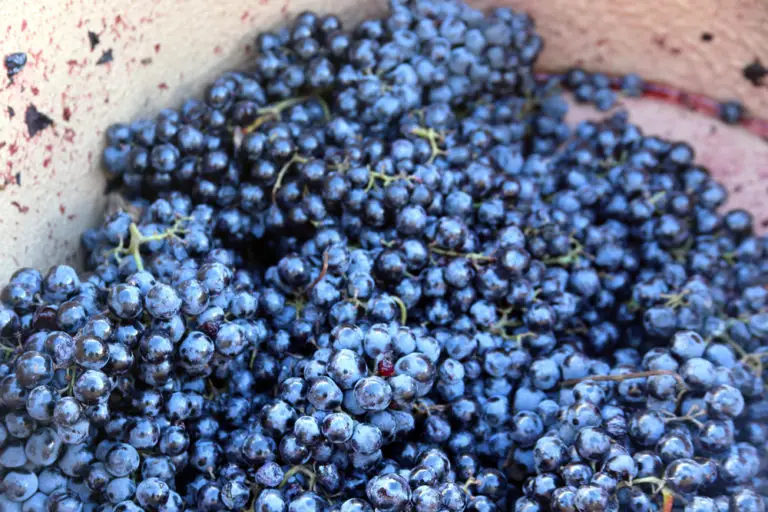Pinot Noir: The Beginners Guide (2024)
Wine Color: Black
Characteristics: Light-bodied and fruity.
Color of berry skin:
Flavor: Dry, medium-high acidity, medium-low tannins.
ABV: 11.5–13.5%
Origin: Burgundy, France.
Notable Regions: France: Burgundy, United States: Russian River Valley, New Zealand: Central Otago, Australia: Mornington Peninsula, Germany: Ahr
Most Expensive Bottle: Domaine de la Romanee-Conti Romanee Conti Grand Cru – All vintages go for an average of $13,109 (1)!
Common synonyms: Blauburgunder, Blauer Arbst, Blauer Spätburgunder, Burgunder, Cortaillod, Mário Feld, Mário Feld Tinto, Morillon, Morillon Noir, Mourillon, Savagnin Noir or Salvagnin Noir.
Pinot Noir is an important red wine variety, usually considered to be of high quality, that has gained worldwide distribution and importance. It is sometimes referred to as the king of red wines and is a classic red wine quality variety of cooler wine-growing regions such as Burgundy. Pinot noir is also an important blending partner for Champagne production.
- What is Pinot Noir?
- Popular Blends of Pinot Noir
- How to Enjoy Pinot Noir?
- How Is Pinot Noir Made?
- History of Pinot Noir
- Alternatives for Pinot Noir
What is Pinot Noir?
Pinot Noir wine is considered one of the finest red wine varieties in the world. Classically, the grape variety is found primarily in cooler wine-growing regions such as French Burgundy or Germany, where it is also known as Spätburgunder.
Pinot noir is also used as an ingredient in champagne. In wine, however, Pinot Noir is almost always varietal. Although Pinot Noir is considered difficult to grow – the vine is susceptible to disease and the Pinot Noir grape skins are thin – the variety is popular, mainly due to the taste quality and lush aroma of the wine made from it.
Pinot Noir characteristics are that they are deep ruby red with violet hues, are considered velvety and full-bodied red wines with long shelf life but low color intensity. The wines oxidize easily (especially after an attack of the berry disease Botrytis) (2) and then show a brownish-red hue.
Pinot Noir has an independent, typical bouquet, which is particularly characterized by its fruitiness. In young wines, the fruit of the wine can be reminiscent of blackberries, in old age they are more reminiscent of nuts with a delicate bitterness.
Pinot Noir vs. Cabernet vs. Merlot vs. Pinot Grigio
Pinot Noir flavor is stronger and lighter than Merlot and Cabernet Sauvignon, but not as light as the white Pinot Grigio vs Pinot Noir. It has medium to high acidity with a fruity taste of cherries, raspberries and plums and hints of tea leaves or damp earth.
It has a soft and velvety texture and lower tannin content. It has a higher alcohol content compared to Cabernet, Merlot and Pinot Grigio wines. It is rarely blended with other wines whereas both Cabernet and Merlot are.
Merlot has a mild taste and aromas of blackberries, blueberries, plums and also some herbal notes with less tannin and acidity. Compared to Pinot Noir vs Cabernet, it has a deeper color and is softer and gentler. It has a higher alcohol content.
Pinot Grigio yields low-acid but full-bodied and extract-rich white wines, usually with a fairly high alcohol content. Pinot Grigio wines usually have a strong golden yellow color, in very good qualities one can sometimes perceive light brown tones, with a light apple tone and a nice freshness.
Pinot Noir Characteristics
The Pinot Noir characteristics produces a red wine of varying character depending on the location, the vine produces light, fruity or strong, full-bodied wines. The wines are full-bodied, soft, and delicate. The complex character of the Pinot Noir grape can only be appreciated with an excellent nose and a fine palate.
The Pinot Noir taste is berry-like: red berries, gooseberries, sour cherries, and raspberries.
However, after a while, an aroma of leather and mushrooms develops. The aging of the wines is very variable and difficult to predict. Quite good wines can be very long-lived and develop even more complex aromas.
Mostly, however, the wine loses its charm. Sparkling wines are made from pinot noir, sparkling rosé, and blanc de noirs (literally, “white from black” is the French term for a white wine made from red wine varieties). Pinot noir is also one of the three grape varieties used in the production of champagne and gives the sparkling wine its fullness.
Pinot Noir Taste Profile
The style, aroma, and Pinot Noir flavor range from almost austere, to acidic, tannic, to unsurpassably smooth, velvety and aromatically complex. The typical Pinot Noir smells slightly sweet of fruit, from cherries, blackberries, strawberries, plums to blackcurrants, with hints of almonds and flowers like violets.
Successful red wines made from the grape variety Pinot Noir or Pinot Noir have an intense, bright ruby red color, but are not as dark as, for example, Cabernet Sauvignon. The characteristic of Pinot Noir is their rich bouquet, which usually reminds of fresh strawberries, wild berries, cherries, or plums.
Spices and herbs as well as mushrooms or leather in ripe wines sometimes rise to the nose of the wine connoisseur. The taste is in no way inferior to the aroma of top wines: aromatic-fruity and full-bodied.
Pinot Noir requires the gentlest possible extraction of its thin-skinned berries, from which one wants to extract as much color, flavor, and aroma as possible without extracting too many bitter tannins. Besides the origin, it is actually above all the sophisticated vinification that characterizes the image of Pinot Noir (3).
Pinot Noir Ageability
High-quality Pinot Noir is ideal for long storage. has very few tannins and therefore can only rely on its antioxidant properties through a long expansion in wooden barrels. The aging of wines varies greatly and is difficult to predict. Quite good wines can be very long-lived and develop even more complex aromas.
Most of the time, however, the wine loses its charm. When aging in barriques, notes of vanilla and cinnamon are often added. Especially with high-quality Pinot Noir, which is matured in oak, long storage in the bottle has a positive effect.
Some wine experts are even of the opinion that a good Pinot Noir needs at least two to three years to even begin to develop its potential. Ageability is also dependent on the climate, French Pinot Noir and Pinot Noirs made in the USA tend to have a better aging potential, as opposed to countries like New Zealand and South Africa, which are better enjoyed as a younger wine.
Known Regions for Pinot Noir
So where do you find the best places for Pinot Noir? Burgundy is its home and probably its best expression. In New Zealand, America, Australia, and even in more traditional white wine countries like Germany, considerable quantities of Pinot Noir are grown.
Burgundy
Pinot Noir is the characteristic grape variety of the Burgundy region (Bourgogne in French) with about 11,000 hectares under cultivation. However, the largest acreage (13,000 hectares) of Pinot Noir is in Champagne. Other Pinot Noir regions include Alsace and Sancerre.
California
California Pinot Noir is the leading wine producer in the United States. The grape variety is grown in areas cooled by the Pacific Ocean winds.
Germany
Germany is the third-largest Pinot Noir producer. The wine is known as Spatburgunder and Pinot Noir is the most widely grown red grape variety in the country.
Australia
Examples of Pinot Noir notable regions in Australia are Southern Highlands, Tasmania, Canberra District, and Yarra Valley.
New Zealand
Pinot Noir is the most widely planted red grape variety in New Zealand (over 5,000 hectares). The grape variety is grown in Central Otago, Marlborough and North Canterbury.
South Africa
South Africa produces some impressive New World Pinot Noir wines. The main Pinot wine regions are Cape South Coast, Paarl, and Elgin.
Chile
Pinot Noir is grown in almost all of Chile’s wine regions – thanks to the cool Pacific winds. Some popular wine regions are Biobio, Aconcagua, and Leyda Valley.
Popular Blends of Pinot Noir
Although in the most popular regions, Pinot noir is made as a single varietal wine. In some areas, notably, Champagne, blend the grape variety with others to create a whole new flavor profile!
- Pinot Noir is one of the most important grape varieties from which champagne is made, along with Pinot Meunier and Chardonnay. Pinot Noir can also be used to make excellent varietal sparkling wines called Blanc de Noir, which have a rich black and red fruit flavor.
- A blend of Pinot Noir and Chardonnay grows in similar conditions and is used to make sparkling wine. Chardonnay is actually a cross between Pinot Noir and Gouais Blanc.
- Winemakers use Pinot Noir for some still white wines. For example, many Italian wine regions use the grape variety in their white wine blends, which are usually rich and very aromatic.
- Pinot Gris, Pinot Grigio, and Pinot Blanc are also used for white wines. However, they produce lighter wines with less complexity and flavor than the Pinot Noir blends.
- To make California Pinot Noir taste stronger and more luscious, a dash of Syrah is sometimes added to it.
How to Enjoy Pinot Noir?
When consuming a Pinot Noir, attention should be paid to temperature and ventilation. The Pinot Noir temperature should be between 12 and 18 degrees. Especially with young closed and “wilder” as well as less balanced wines, aeration for 30 minutes or more can contribute to a more pleasant drinking experience. This is ultimately a matter of taste.
Food Pairings
As Pinot Noir tends to be one of the heavier types of wine, which is also excellent on the tongue, this elegant Pinot Noir food pairings is ideal for meat dishes with game, duck, pheasant or beef. Slightly chilled, it is also suitable as a noble drop to cheese hors d’oeuvres or canapés.
Pinot Noir taste well with a variety of foods – fruitier versions pair well with salmon or oily fish, roasted chicken or pasta dishes like spaghetti bolognese; larger, more tannic Pinot Noirs are best matched with duck and other game, casseroles or, stews such as beef bourguignon, beef estofado or Ossobuco.
It is also a perfect match for earthy dishes like mushroom and beef stroganoff, truffled dishes, lentils or mushroom risotto. Great dessert pairings could include; chocolate-covered strawberries, dark chocolate mousse, or rich brownies.
Desserts with forest fruit are best served with a Rosé or any Champagne with a high percentage of Pinot Noir.
Temperature
Is there an optimal Pinot Noir temperature serving? Temperature affects how you perceive the wine’s flavors, so serving at the right temperature can enhance your enjoyment. So the popular wisdom about room temperature for red wine can be safely forgotten.
It is centuries old – and thus dates back to a time when rooms were heated to a maximum of 19 °C and not to at least 22 °C, as is common today. Serve Pinot Noir slightly chilled at a temperature of 12-15 ° C. This temperature can be set appropriately for almost all medium-weight red wines.
Only if these, like e.g. high-quality French Pinot Noir wine, have gained additional complexity and depth by maturity, it may be 1 to 2 degrees more. A younger Pinot Noir wine probably doesn’t need to be decanted. However, if you want to open a 10-year-old Pinot Noir, you should let it breathe for 20-30 minutes so that all the aromas can develop in their full complexity and depth.
Stemware
In general, the proper wine glass is distinguished chiefly by its simplicity: It is not the glass that plays the leading role, but the wine. The right wine glass is therefore as clean as possible, thin-walled, uncolored and unpolished, and long-stemmed.
In addition, the rim of the wine glass should be large enough for the nose to still fit in at the top in order to smell (depends on the tines, of course) – this way, when sniffing and tasting the noble drop, all Pinot Noir characteristics can be optimally perceived with nose and mouth. Thus, the sensory pleasure that such a wine brings is greater.
For particularly strong red wines such as Pinot Noir, a Burgundy glass (balloon-shaped) with wider but shorter side walls is recommended. These wines need a lot of air supply, so the full-bodied aroma can develop best.
Since the wine has particularly pronounced fruity notes, the surface here must be as large as possible. In this way, they come out even better. The Burgundy glass is therefore the most bulbous and voluminous of all.
How Is Pinot Noir Made?
In Pinot Noir wines, the soil, the climate, the location of the Pinot Noir vineyard and the altitude are superbly expressed. This is why winegrowers choose the location of their vineyards very carefully.
- Clones: some winemakers plant some Pinot Noir clone varieties to increase the complexity of the wine, while others prefer to stick to one clone. (4)
- Organic viticulture: The Pinot Noir grape is very sensitive to external influences. Many winemakers have therefore opted for organic viticulture and avoid chemical fertilizers.
- Grape harvest: The winemaker must decide whether to ferment the whole clusters or just the grapes. Fermenting the whole grapes increases the tannin content of the wine (as Pinot Noir has a very low tannin content) (5).
- Fermentation: this is done in open vats where the grape skins come into contact with the grape juice and the sugars turn to alcohol (6).
- Fermentation temperature is another crucial factor. If the winemaker ferments the grape must at cooler temperatures, the wine will have more residual sugar and a fresh, fruity aroma (7).
- Cold maceration: this is another popular technique where the winemaker crushes the grapes at temperatures of 4-15°C. This allows for better extraction of color, aroma, and tannins (8).
- Second fermentation: some winemakers use French oak barrels to age the Pinot Noir. The oak barrels give the wine its flavor and soft tannins (9).
History of Pinot Noir
The history of Pinot Noir is probably one of the oldest grape varieties still in cultivation in the world. More than 2000 years ago, during Roman rule over Gaul, winemakers in what is now Burgundy bred it from a wild vine and cultivated it (10).
The Pinot Noir grapes have tightly hanging berries and resemble a large pine cone. Since “pin” is the French term for pine trees, it is assumed that this is where the name of the grape variety comes from. The many regional name variations prove that the variety was not only cultivated in its French homeland.
Some sources speak of an incredible 300 synonyms for Pinot Noir. Its name, by the way, comes from the French word for pine cone. This is because the individual berries in the cluster are just as small and close together (11). Further developments and crossbreeding are considered to be further indications of its long history.
Over the centuries, mutations have arisen that are sometimes considered to be grape varieties in their own right, such as Pinot Meunier (Black Riesling), Pinot Grigio (Pinot Gris), and Pinot Blanc. They belong to the so-called Pinot or Burgundy family. And this is widely branched. There are many cultivated clones of Pinot Noir, as many as 50 are officially recognized in France alone (12).
Alternatives for Pinot Noir
As much as we love Pinot Noir, there are so many other, lesser-known red grapes that are structurally similar to it – which means there are tons of other refreshing, cooling, and downright delicious red wines you can satisfy your cravings with. We’ve rounded up alternative varieties for those who’re crazy about Pinot Noir. Just pour, serve slightly chilled and let it quench your thirst.
Gamay
This red grape variety with high acidity is closest to Pinot Noir. It produces refreshing, light wines with spicy, candy-like raspberry and cherry flavors. The Crus produce slightly richer, higher quality wines. These can sometimes age for a surprisingly long time. While the Primeur is drunk young, some Gamay from the 10 Crus of Beaujolais reach an age of up to 20 or even 30 years.
Garnacha
The wine from the Grenache grape is low in tannin and color. It can therefore produce good fruity wines and is also vinified as white or rosé wine. Under extreme climatic conditions (drought, heat and wind) and with very low yields, the Grenache also produces concentrated, very storable red wines.
Mourvédre
Mourvédre is a red wine variety used mainly in Spain and southern France, but also grown in Australia and California. This grape variety originated in Spain, where it was formerly called Mataró and is now called Monastrell. Mourvédre yields a tannic, dark-colored wine that requires long bottle ageing to reduce astringency. It is so aromatic that it also goes well with Mediterranean cuisine dishes that are intensely flavored with herbs.
FAQ
Is Pinot Noir a good wine?
Yes, Pinot Noir is a very versatile grape variety that makes excellent wines around the world. This easy-drinking wine is a sure crowd pleaser!
Which is sweeter Merlot or Pinot Noir?
Both grape varieties make a dry wine, but because it is grown in warmer climates, Merlot gives the perception of a sweeter wine with its ripe fruity flavors.
Why is Pinot Noir so popular?
Pinot Noir is one of the most popular red wines in the world. It is made from black-skinned grapes that thrive in a narrow range of cooler climates. When properly vinified, it produces light, elegant, complex, and long-lasting wines.
Is Pinot Noir the best grape?
Although more prone to diseases than other grape varieties, Pinot Noir can also be grown in a wider range of climates making it better to cultivate around the world.
How do you pick a good pinot noir?
Do your homework – talk to people who drink Pinot Noir wine and ask them for recommendations. If you go to a wine shop, talk to the professionals there and ask them for help, before you blindly decide on a bottle because the label looks nice!
Why is Pinot Noir so expensive?
Pinot Noir grape yields are low, which contributes to its rarity. Production tends to be intensive and small-scale, which adds to its value. It is usually aged in new French oak barrels, which are not cheap.
Is Merlot stronger than Pinot Noir?
With more subtle tannins and lower acidity, Merlot is an easy wine to enjoy, but the Pinot Noir flavor is stronger than Merlot.
How do you drink Pinot Noir?
Pinot noir is best served slightly chilled. Pinot Noir likes to be served from the bottle and does not necessarily need to be decanted. Drink your Pinot Noir from a large, bell-shaped glass to best enjoy its aroma.
What type of wine is Pinot Noir?
Pinot Noir wines are deep ruby red with violet hues, widely considered velvety, and full-bodied red wines with long shelf life but low color intensity.
Is Pinot Noir red or white?
Pinot Noir is one of the most popular red wines in the world. It is made from black-skinned grapes that thrive in a narrow range of cooler climates.

